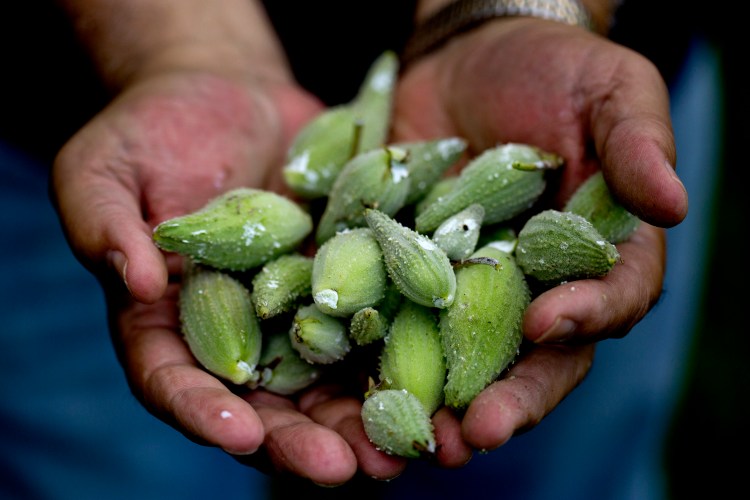Brunswick resident Mike McNally has foraged fiddleheads his entire life. But it wasn’t until three years ago that he started seeking out common milkweed pods to eat.
McNally was about to give up his longtime podiatry practice. He and his wife, Betty, were taking steps to eat more foods with fewer pesticides in hopes of sustaining a long retirement. They armed themselves with Tom Seymour’s “Wild Plants of Maine” foraging guide and targeted mushrooms, because they really liked those, and milkweed pods, because they regularly noticed them around many of their favorite midcoast picnicking spots.
Milkweed is a perennial herb found in old fields and small clearings, and on roadsides, stream sides and fencerows. Milkweed shoots (which resemble asparagus stalks and are also edible) rise out of the plant’s decomposing stalks from last year. Flower buds (which resemble immature heads of broccoli and are also edible) appear in early summer and are favored by Monarch butterflies. The pods come two to three weeks after the flowers have bloomed and dropped off.
“When you harvest the pods less than 2 inches long, and eat them sautéed whole, they are crazy good,” McNally said. When the pods are young, both the outer covering and the silk inside are very tender. The pods still have to be twice boiled and drained to remove any bitterness. McNally describes the taste of the finished product as a somewhat sweet mix between fiddleheads and fresh green beans.
“On our first picking of the season, we tend to eat enough of them so that they count as the whole meal,” said McNally. But as the season progresses, the McNallys eat them as a side dish with local fish.
He will break open bigger pods – those less than 4 inches long – and remove the inner floss that gets tough and stringy as the pod matures. He then sautés the empty pods as he would the whole ones. The larger pods also can be stuffed, with wild mushrooms perhaps.
McNally’s go-to place for picking milkweed is very near his McKeen Street home, in a patch that runs along a town soccer field. The Merrymeeting Bay Wildlife Management Area in Bowdoinham is chock full of them as well. McNally isn’t shy about sharing his harvesting spots. The milkweed are always pretty abundant, especially so this summer. But McNally does caution foragers not take 100 percent of any plant from the wild.
“That would mean less for both butterflies and me in the future,” said McNally.
SAUTÉED MILKWEED PODS
Mike McNally knew these foraged sautéed pods would become a standard summertime treat when he cooked them for the first time three years ago because his wife – who doesn’t normally go for leftovers – beat him to the pods that were left in the fridge the day after he’d made them for dinner.
Serves 4 as a side dish
Two dozen whole milkweed pods, each less than 2 inches in length.
1 to 1½ cups all-purpose flour
2 tablespoons unsalted butter
1 tablespoons olive oil
Sea salt and freshly ground black pepper
Place pods in a 4-quart saucepan and cover with cold water. Bring to a boil, and boil the pods for 10 minutes. Drain the pods. Repeat the process once more.
Place one cup of flour in a plastic bag. Place 6 pods in the bag and shake to coat with flour. Take pods out and spread them on a towel. Repeat process, adding more flour if necessary, until all of the pods are coated.
In a large skillet, melt the butter in the oil until the butter foams. Add pods and allow them to cook undisturbed for 3 to 4 minutes until the undersides get a bit of a golden crust. Stir and cook another 3 to minutes until the pods are tender.
Season with sea salt and pepper. Serve warm.
Send questions/comments to the editors.



Comments are no longer available on this story